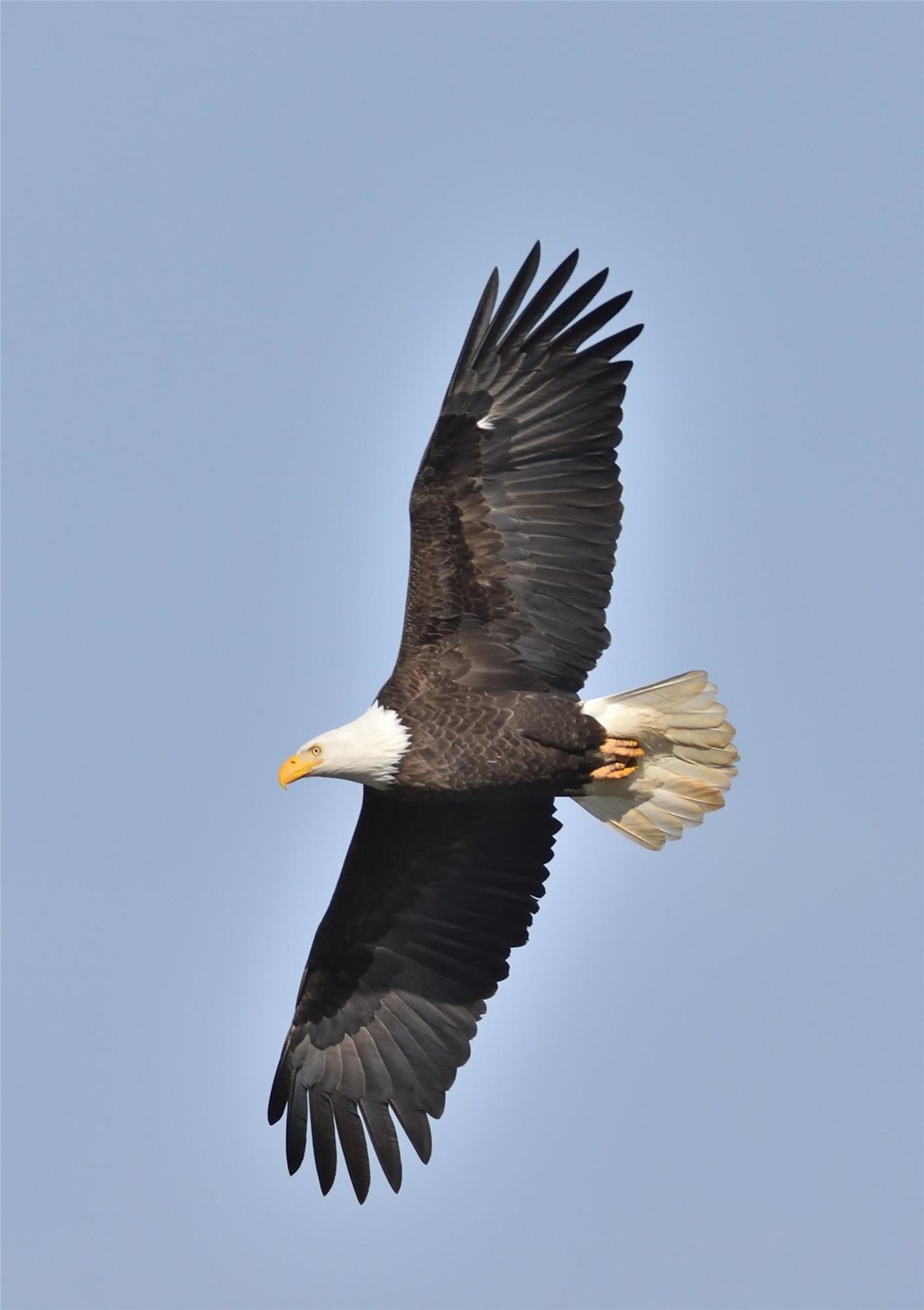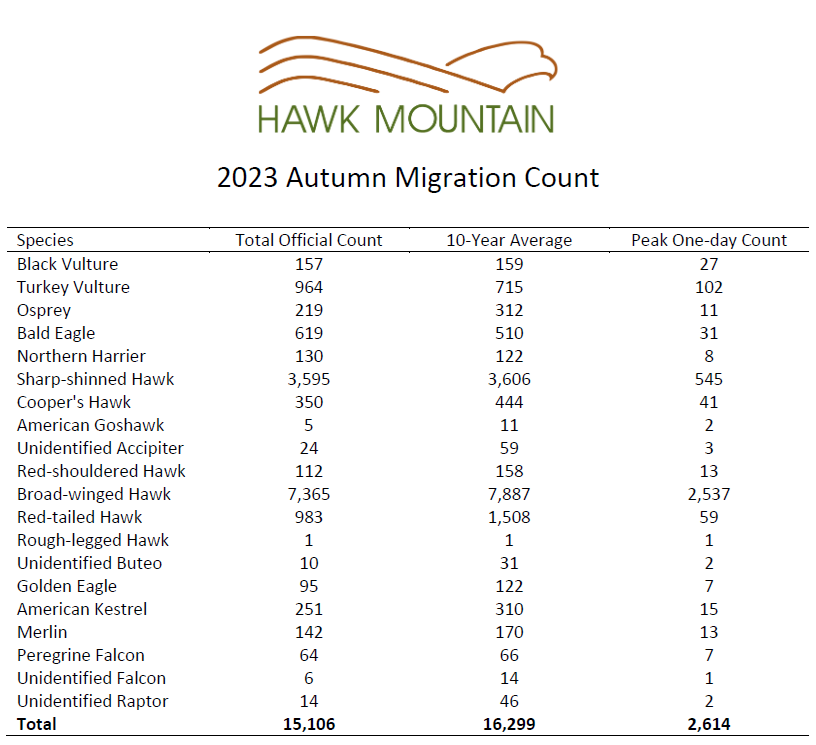Fall 2023 Migration Wrap Up
Posted on December 22, 2023 in Science

The 2023 autumn migration season came to an end on December 15, with a total of 15,106 migrant raptors tallied since the start of the count on August 15. The final official day of the count was an exciting one with nine bald eagles spotted, setting a new all-time record for the species at 619 for the season! Also counted were four turkey vultures, which solidified a total of 964 for the season, the second highest count total for the species. The final migrant of the season was an adult red-tailed hawk.
Five staff, 14 volunteer counters and five trainees manned the lookout for 1,095 hours across 120 days scanning the skies, while welcoming the 14,647 visitors to the lookout engaging them with the viewshed, orographic lift, and the nuances of raptor migration.
Overall, it was a below average year; the season total of 15,106 was 7% below the 10-year average. Nine of 16 species had below average counts, most notable were American goshawk, 56% below average, red-tailed hawk, 34% below average, osprey, 29% below average, and golden eagle, 22% below average. Hawk Mountain isn’t an outlier though, counts of osprey, goshawks, redtails, and goldens were below average for all watchsites in the state.
Northwest winds leading into the broad-winged hawk peak were setting them up to come in under the 10-year average, but the count was salvaged as east winds blew the tail end of the migration back into the ridge, giving a day count of 2,537 late on September 22 ahead of a tropical system. This represented a third of all the broad-winged hawks counted for the season with our second highest daily count coming to 813 individuals. Broadwings have long been one of our most variable species given their dependency on thermal lift and being subject to the whims of the wind. This point was highlighted this season as hawk watches southeast in the piedmont enjoyed record breaking kettles of broadwings during their peak. Red-tailed hawk and golden eagle numbers were down significantly, and indicators are pointing to birds staying further north as count sites from across PA ended their counts with below average passage for both. It speaks volumes that our high daily count of red-tailed hawks came in at 59—a far cry from triple digit days of the past. Lack of snow cover and warmer temperatures kept resources available, encouraging opportunistic birds to remain further north. This was apparent as snow in the Adirondacks, the week prior to our count closing, coupled with stronger northwest winds brought a pulse of eagles, red-tailed hawks, and turkey vultures past the lookout. Rather than sustained frontal systems moving through, the Kittatinny experienced rapid pressure gradient shifts where reduced visibility low-pressure systems transitioned to high-pressure bringing a day of ideal winds followed by clear skies and calmer atmosphere promoting thermal lift, striking challenging conditions for spotting high flying migrants.
A cold front on October 16 brought our sharp-shinned hawk peak as 545 individuals made for busy scanning as they popped out of a cloudy backdrop on northwest winds. This was followed the next day by another 371 sharp-shinned hawks and also saw our peak October diversity flights as both days enjoyed looks at 13 of our migratory species. American kestrel numbers were down significantly while merlin and peregrine falcons came in close to their average flights, providing high paced encounters as they worked the owl or heckled other migrants moving down the ridge. Bald eagles were almost a daily presence as local birds soared from behind the lookout, moving up ridge to intercept migrants or hanging in a thermal overlooking the little Schuylkill, being a highlight many visitors’ time on the rocks.
The flights during the last week of the count indicate that migrants will continue to move into the region as winter lays claim to regions of New England. A long-time photographer and volunteer reported that on the frontal winds Tuesday the 19th, golden eagles were still soaring down the ridge. So, with an eye to the wind, a strategic hike to North Lookout could yield an excellent flight for those who haven’t had enough watching the masters of the atmosphere.
Check out daily and seasonal counts here.

Non-Raptor Highlights
Counters also tallied 65,054 non-raptors from including 129 species of birds, 11 species of butterflies, and 3 species of dragonflies. Notable birds seen this fall were sandhill crane, anhinga, and the first record of wood stork for North Lookout.
Wood stork was added to the Sanctuary list as a single individual soared high overhead on September 6. This southern vagrant was joined a week later as an anhinga soared high in a thermal at the front of the lookout. Small groups of sandhill crane were seen, their wild bugles identifying their presence for those lucky enough to hear. Early September saw an excellent push of neotropical migrants, especially on September 4 when 82 ruby-throated hummingbirds buzzed past the lookout after an excellent morning flight of 15 species of warbler including black-throated green, Cape May, and blackburnian warblers. The following day tallied 122 Cape May warblers moving across the lookout. An adult male cerulean warbler that kept coming up the American chestnut tree was a knockout encounter. Neotropics put in a drawn-out passage with some species of warbler showing up slightly earlier than expected but weather made it challenging for dawn on the rocks as winds pushed songbirds past the lookout as they descended with dawn’s arrival. Predawn thrush flight calls on the Sanctuary indicated a surprisingly strong passage along the ridge, listening to flight calls switch to contact calls as Swanson’s, gray-cheeked, wood, and hermit thrush Utilized the Sanctuary woods for shelter.
Swallows also put on a good show as there were several weeks when mixed flocks of purple martin, tree, barn, northern rough-winged, cliff, and bank swallows joined the chimney swift in acrobatic pursuits of flying insects past the lookout. Flycatcher numbers were typical, with some excellent mornings of olive-sided flycatcher, least, and yellow-bellied hawking insects adjacent to the lookout.
Winter finch flight forecast had the potential for red crossbills, which were eventually seen in small flocks bouncing down the ridge giving their “jip-jip” flight calls. The bulk of the finch flight came from a surprisingly strong pine siskin flight through October joined by purple finch, American goldfinch, white-winged crossbill, and one small group of common redpolls.
Similar to the late season raptors, waterfowl movement was relatively light this season until the final week of the count when inclement weather to the north saw 3,468 Canada geese joined by snow geese, tundra swans, mallards, and five black scoters. Both common and red-throated loon were observed winging over the lookout, and one flock of Atlantic brant were spotted.